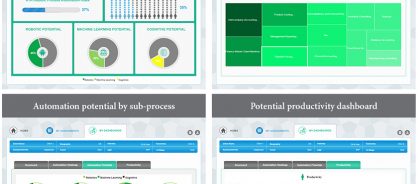- Solution overview
The Intelligent Automation Index
Target digital investments by pinpointing where automation has peak potential

Widespread digital disruption has put transformation at the heart of many corporate strategies. Robotic process automation (RPA) is already helping companies compete in the short term. But as technologies evolve, leaders can expect longer-term gains if they move to intelligent automation.
On its own, RPA handles more volume than manual processing with greater accuracy, works faster and heightens productivity. It frees people up from repetitive work such as invoice processing, data reconciliation, and journal entry processing.
As organizations combine RPA with cognitive solutions these technologies evolve into intelligent automation. Today, artificial intelligence through natural language processing, speech recognition, and machine learning can mimic human responses so more complex processes can also benefit from automation.
Intelligent automation has the potential to deliver strategic business outcomes while delighting customers and enhancing their experiences. Success, however, depends on creating an effective road map for deploying the right technology.
Take a copy for yourself
Challenge
Know what you need to know
Your firm might see the potential for intelligent automation but be unsure how best to use it to reach its goals. Here are some steps to help you along the way:
- Prioritize use cases: Intelligent automation success depends on identifying the time-consuming and labor intensive processes most suited for RPA, such as those that are deterministic and rules-based.
- Select capable tools and operators: Some processes call for basic RPA while others can take advantage of machine learning and other cognitive capabilities. It's important to understand what each solution does, how it works and what are its limitations.
- Be realistic about ROI: Intelligent automation is still at a nascent stage, so it's easy to get caught up in the hype about its capabilities. But you'll risk getting discouraged if your company's initiatives don't meet their objectives. And you could set yourself up to fail if you expect results too quickly or underestimate the work you have to do to apply new tools to complex processes.
- Define a clear governance structure: Good governance and planning help firms stay focused on priorities and get buy-in and adoption from stakeholders. Before you begin automating, standardize your processes and find a way to track performance. You'll also need to manage change, map roles and responsibilities, and address any risk, compliance, and security concerns.
Solution
Intelligent Automation Index
Intelligent Automation Index, Genpact's proprietary and patented framework (US patent number 10885486) assesses and quantifies the potential of RPA using industry and ERP-specific taxonomies. It examines three automation types – basic robotics, machine learning, and cognitive automation – and indicates the productivity potential of each one.
The index enables you to make good choices about RPA and intelligent automation. These technologies are part of Genpact Cora, our AI-based platform that accelerates digital transformation.
Its key features include:
- Automation parameters: Genpact has identified process parameters that influence the potential for RPA (figure 1) and has classified them in three groups – confirmatory, exploratory, and informatory.
- Process-level assessment: The taxonomies have five hierarchies, with level five being the most granular. The index evaluates each level-five task to determine the automation potential for each level of process taxonomy. It also calculates values by process and sub-process to identify the best areas to introduce automation for maximum efficiency.
- Reporting: The index also determines potential improvement in efficiency based on the automation potential of level-five activities, time, effort and other relevant factors. Users can drill down into the index for more detail at a process and sub-process level. Finally, the index produces detailed reports to prioritize and validate business cases and become the basis for the subsequent design and deployment phases for RPA
Figure 1: Dashboards allow users to assess the RPA business case

The Intelligent Automation Index combines design-thinking methodologies and lean methods with process-centric digital technologies and analytics. Genpact's deep domain knowledge and process expertise also comes in to play. Our RPA experts and consultants have built their experience from over 6000 automation implementations.
Intelligent automation lifecycle
As you deploy intelligent automation, Genpact is with you on every step of the way. Here's how the journey unfolds
Assess: First, our index and experts identify and prioritize processes ready for RPA and intelligent automation, then create a road map for deployment.
Design: Genpact helps to restructure and standardize processes with controls, best practices, and KPIs before automating takes place.
Deploy: Our teams codify and test the prioritized processes, and run training workshops to help organizations transition to new ways of working.
Evaluate: Working with stakeholders, Genpact uses the Intelligent Automation Index to monitor progress against the road map, track performance against benchmarks, and identify necessary adjustments.
Maintain: Genpact manages ongoing governance and maintenance while the organization prepares to add more automation.
Impact
Getting the most from your intelligent automation investment
The Intelligent Automation Index enables you to prioritize and cut through the many other automation decisions organizations face. The result: Your company can execute solutions that have the right capabilities. and clear ROI expectations.
Applying basic RPA improves accuracy, productivity and saves time. As companies extend their investments to include advanced cognitive solutions, they find they they can impact the company's growth, transform the workplace, and delight customers and users alike.
For more insights, read our point of view on the power of intelligent automation.